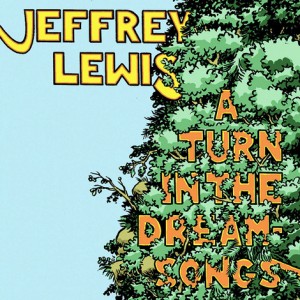 The leaves have browned and are falling in Central Park, busloads of tourists are flocking in for the storybook ‘autumn in New York’ experience, and the countdown is on to the Hallowe’en Parade. Jeffrey Lewis, meanwhile, should be home by Christmas.
The leaves have browned and are falling in Central Park, busloads of tourists are flocking in for the storybook ‘autumn in New York’ experience, and the countdown is on to the Hallowe’en Parade. Jeffrey Lewis, meanwhile, should be home by Christmas.
He bases himself in Manhattan, collects his mail from Cooper Station Post Office on the corner of 4th Avenue and East 11th Street, but just now, and at the time of writing ‘now’ is early October 2011, home is the road. Tonight Sligo, tomorrow the world. Or whatever route connects Sligo to Exeter.
Europe now, Canada and the US next. It was Germany, China and South Korea in the summer. But any impression Lewis might slowly be coming detached from his home city is knocked firmly on the head by A Turn In The Dream Song.
This is the sixth solo Jeffrey Lewis album, and at a stretch it can be called his Manchester record. Recorded, mid-tour, at the Analogue Catalogue studios in Mossley, Greater Manchester, in the foothills of the Pennines, it comes laced with tales of heartbreak and self-deprecation, seasoned with a heavy seasoning of the surreal, and infused with indiepop cameos. Yes, that really is Lucy from Misty’s Big Adventure wrapping saxophone around the gentle freak-out of To Go And Return. And indeed, that’s Frances McKee of The Vaselines hollering backing vocals on the whipsmart Cult Boyfriend, a typically nerdy, wordy frolic with a barrage of neat rhyming couplets. Like this: “I might not be in magazines as a heart-throb face/But in a few devoted hearts I’ve found a strong fan base.”
So A Turn. is flavoured with a sprig of British lavender, but there’s always something else hanging in the air: the scent of Stanton Street, the aroma of Alphabet City, the honk of Houston Street. Even when they’re not thematically linked, the songs and the city are working as one. If the accent was Mancunian and not Manhattan, Lewis’ freewheeling ways would see him accused of being gobby, but think of the acts which sprung from New York and their particular force in the spoken or sung word, and count him in their company. Take the early writers on Broadway, add Dylan, Wu-Tang Clan, Sonic Youth, Patti Smith and latterly the likes of Adam Green, Kimya Dawson, the Strokes and Jay-Z – then work outwards from there. Lewis is quietly brassy, a dry wit and an eloquent storyteller, a prolific chronicler both in rhyme and as a comic book artist, and A Turn. is a charming arrival.
He may still have to wait forever for that momentous day when, as he once put it, his records and comic books become “rare cult-collector items”. But New York has embraced outsider artists before – just look at Woody Allen. Allen found fame and fortune via the medium of his anguished stories about girls, oddball comedy and acidic observations about the Big Apple. The cards fell in his favour, all right.
It’s been three years since Lewis went through a difficult break-up (see his version of events). And on How Can It Be, he pleads the rather simpering: “I know you love his family/But is that really any reason to love him instead of me?” Yet with Try It Again he’s got an outré pop thing happening, notwithstanding its self-mocking lyrics. For instance: “I’ve got a room to myself, I’ve got my art and my health/This loneliness in my guts, must just mean that I’m nuts.” It’s business as usual, then, with the themes addressed by this rather special orator, except on album six Lewis’ writing is scaling new heights. Forget those falling leaves, this could be the high summer of his career.
Words: John Skilbeck
